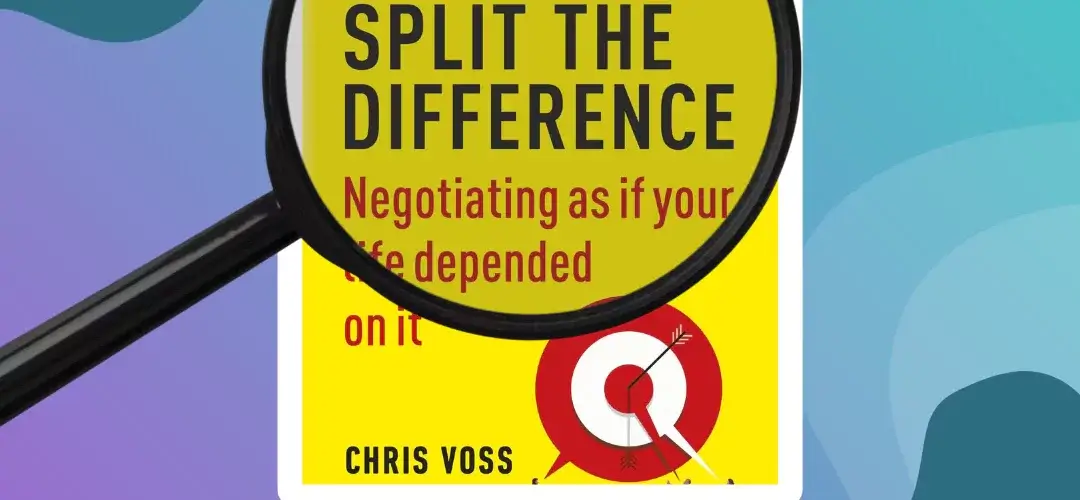Embark on a journey to master negotiations with our deep dive into Chris Voss’s Never Split the Difference. This article explores the book’s key concepts, author profile, practical applications, and critical reviews.
Key Takeaways:
-
Chris Voss’s Expertise – Learn how decades as the FBI’s lead hostage negotiator shaped the book’s field-tested negotiation strategies.
-
Empathy and Mirroring – Understand how tactical empathy and the mirroring technique can transform conversations and uncover hidden insights.
-
Accusation Audit & the “That’s Right” Moment – Explore two of Voss’s most effective tools for dismantling objections and building alignment.
-
Critical Perspective – Evaluate both the strengths and potential blind spots of Voss’s approach.
-
Practical Applications – See how these principles translate into sales, leadership, hiring, parenting, and even conflict resolution.
Table of Contents:
- Introduction: Why This Book Still Matters
- The Author’s Profile – Chris Voss
- Never Split the Difference Summary
- Beyond the Basics: Key Tactics Reimagined for Today
- Expert Critique of Never Split the Difference
- Practical Applications of Never Split the Difference in Everyday Life
- Conclusion
- FAQs: Never Split the Difference
Introduction: Why This Book Still Matters
In today’s high-stakes world of business, sales, and personal relationships, negotiation is no longer a specialized skill—it’s essential. Never Split the Difference by former FBI hostage negotiator Chris Voss redefined how people approach high-pressure conversations. Nearly a decade after its release, its lessons remain highly relevant in 2025, especially in remote work, global markets, and digital-first customer interactions.
This article goes beyond a summary. It offers critical analysis, updated applications, and insights drawn from real-world sales and CRM experience. Think of it as your guide to applying elite negotiation strategies in modern contexts.
About the Author: Real-World Expertise from the FBI to the Boardroom
Chris Voss spent over two decades as the FBI’s lead international hostage negotiator. His experience negotiating with terrorists, kidnappers, and bank robbers led him to distill his tactics into principles that anyone can apply.
“Negotiation is the art of letting someone else have your way.” – Chris Voss
Backed by behavioral psychology and field-tested under extreme pressure, Voss’s strategies are rooted in empathy and tactical communication—skills that go far beyond business and sales.
Never Split the Difference Summary
Never Split the Difference breaks down complex negotiations into digestible strategies. Voss punctuates his points with real-life anecdotes from his time in the FBI, adding a gripping layer to his lessons. The central theme, as the title suggests, is a challenge to the conventional wisdom of seeking compromise in negotiations. Instead, Voss advocates for understanding and influencing your counterpart’s emotions and decisions through empathy, active listening, and well-timed questions. This profound yet practical approach promises to alter the course of any negotiation, be it a multimillion-dollar deal or a family disagreement.
Beyond the Basics: Key Tactics Reimagined for Today
Empathy as a Strategic Asset
Empathy in Voss’s world isn’t about being soft—it’s about control. Tactical empathy involves identifying and vocalizing the emotions and concerns of your counterpart. In today’s customer-centric sales environments, this is essential for trust-building.
Try this: Use empathy-driven scripting in your sales outreach to reflect the pain points you’ve identified from customer behavior.
Mirroring: Subtle Power in Repetition
Mirroring involves repeating the last few words your counterpart says in a questioning tone. It’s simple, disarming, and surprisingly effective at drawing out more information.
Tip: Train your sales reps to use mirroring in discovery calls to uncover deeper needs without sounding intrusive.
The Accusation Audit Concept
Preempt objections by naming the worst things your prospect might be thinking. This reduces resistance and makes you appear radically transparent, ripping away any defenses of the other parting and paving the way for a productive discussion.
Use Case: In enterprise sales, this tactic can soften rigid procurement teams by showing you understand their skepticism before they voice it.
Trigger the “That’s Right” Moment
Voss identifies the moment when your counterpart says, “That’s right,” as a pivotal point in negotiations. Getting someone to say “That’s right” (rather than “You’re right”) indicates deep alignment. It’s the inflection point where influence begins.
Sales Scenario: Use reflective summaries during demos to confirm mutual understanding before presenting pricing.
Expert Critique: What the Book Doesn’t Tell You
While powerful, Voss’s methods demand nuance. Without emotional intelligence, tactics like mirroring or labeling can feel manipulative. Additionally, the book gives less attention to long-term relationship-building, where compromise sometimes remains necessary for sustainable partnerships.
Practical Applications: Beyond Business
Voss’s negotiation playbook isn’t just for boardrooms—it’s life advice.
-
In Hiring: Anchor salary negotiations with empathy and a deep understanding of the candidate’s motivations.
-
In Parenting: Use calibrated questions (“What’s the best way to solve this together?”) to encourage cooperation.
-
In Conflict Resolution: Use labeling (“It seems like you’re frustrated…”) to de-escalate emotionally charged situations.
Conclusion: No More Compromise—Only Clarity
Voss teaches us that compromise is often a cop-out. Instead, clarity, empathy, and strategy can lead to better outcomes for all parties. Whether you’re negotiating a contract, a raise, or family screen time rules, the principles of Never Split the Difference are a must-have in your toolkit.
By focusing on empathy, trust, and strategy, you can achieve better outcomes for everyone—whether negotiating a contract, a promotion, or even screen time with your kids.
This mindset aligns perfectly with sales, where tools like Teamgate CRM help teams operationalize Voss’s principles. By capturing customer insights, prompting active listening, and structuring data-driven conversations, Teamgate CRM empowers teams to negotiate with empathy and precision.
Experience firsthand how powerful Teamgate CRM’s platform can be in enhancing your team’s ability to connect, negotiate, and close deals more effectively than ever before.
If you’re looking for a concise way to absorb the key lessons from Chris Voss’s book, you can check out Headway book summaries — a library of bite-sized summaries to help you grasp main ideas quickly.
Start your journey towards negotiation excellence and sales mastery now with a Teamgate CRM FREE trial.
FAQs: Never Split the Difference
1. What are the main principles of Never Split the Difference?
– The main principles of Never Split the Difference involve the use of empathy, active listening, and targeted questions to influence outcomes in negotiations. These techniques move away from traditional compromise-based tactics and focus on understanding and aligning with your counterpart’s motivations and emotions.
2. How can the strategies from Never Split the Difference be applied in business negotiations?
– The strategies from Never Split the Difference can be applied in business negotiations by fostering connection and understanding. Techniques such as mirroring, which involves mimicking the counterpart’s language and behavior, can build rapport and encourage cooperation. The accusation audit can be used to preemptively address potential criticisms or objections, paving the way for more productive discussions.
3. What is the role of empathy in Chris Voss’ negotiation techniques?
– Empathy plays a significant role in Chris Voss’ negotiation techniques. It goes beyond simply understanding the other party’s feelings; it involves recognizing their perspective, their fears, and their aspirations. By displaying empathy, negotiators can build trust, foster connection, and positively influence the negotiation’s outcome.
4. How can I use the “mirroring” technique in my negotiations?
– Mirroring in negotiations involves subtly mimicking your counterpart’s language and behavior. This technique fosters a sense of familiarity and rapport. You can implement this by reflecting your counterpart’s words or expressions back at them, which can make them feel understood and also provide insight into their thinking.
5. What is an “accusation audit” as presented in Never Split the Difference?
– An accusation audit in Never Split the Difference is a pre-emptive negotiation technique where you list and address the worst accusations your counterpart could make against you. This approach can defuse potential defenses and establish a groundwork for productive dialogue.
6. What does a “that’s right” moment mean in the context of negotiation?
– A “that’s right” moment in a negotiation is when your counterpart acknowledges they feel understood and agrees with what you’ve said. According to Chris Voss, achieving this moment is a critical step towards reaching your negotiation goal.
7. Can I use Never Split the Difference tactics in personal relationships and everyday life?
– Absolutely. The tactics presented in Never Split the Difference can apply to a wide variety of situations beyond formal negotiations. These techniques can help navigate disagreements in personal relationships, facilitate discussions in group settings, or even assist in situations such as salary negotiations or disputes with service providers.
8. What is Chris Voss’ background, and how did it influence his book?
– Chris Voss is a former FBI hostage negotiator, and his background heavily influences Never Split the Difference. His experiences dealing with high-stakes, high-pressure situations gave him unique insight into human behavior and negotiation tactics. This knowledge, combined with his natural storytelling ability, gives the book its distinctive, compelling voice.
9. How has Never Split the Difference changed traditional approaches to negotiation?
– Never Split the Difference challenges the traditional negotiation approach of seeking a compromise. Instead, Chris Voss suggests focusing on understanding and influencing your counterpart’s emotions and decision-making through empathy, active listening, and pointed questioning. This shift from a logic-based to an emotion-based approach has significantly impacted how negotiations are viewed and conducted.





